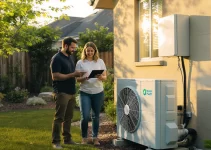Heat pumps have become a cornerstone of sustainable heating and cooling, offering impressive efficiency gains over traditional systems. However, even the most advanced units can suffer performance drops if maintenance or heat pump repair is neglected or issues go undetected. For homeowners and businesses invested in energy-efficient heating solutions, mastering advanced troubleshooting and repair is essential.
This guide will walk you through modern diagnostic techniques, common efficiency pitfalls, and actionable maintenance strategies to keep your heat pump operating at peak performance year-round.
The biggest troubleshooting gains in 2025 come from predictive maintenance—AI-driven sensors can detect coil fouling, refrigerant leaks, and airflow blockages before efficiency drops.
Understanding Modern Heat Pump Repair Technology
In 2025, heat pumps are more sophisticated than ever. With SEER2 ratings between 18–22 and HSPF2 ratings of 9–11, they deliver 15–20% better efficiency than models sold just five years ago. These gains come from variable-speed compressors, advanced refrigerants, and integrated smart diagnostics.
Moreover, modern units often include IoT sensors that continuously monitor refrigerant pressures, airflow rates, and coil temperatures. This data allows for predictive maintenance—addressing issues before they escalate into costly heat pump repair. Some systems even integrate with weather data, adjusting performance in anticipation of temperature swings or humidity changes, which reduces unnecessary strain on components. For example, a heat pump in a coastal environment can preemptively adjust its defrost schedule based on predicted dew point changes, avoiding salt-air corrosion and ice buildup.
| Feature | Benefit | Impact |
|---|---|---|
| Variable-speed compressor | Reduces cycling losses | +12% efficiency |
| Low-GWP refrigerants | Lower environmental impact | Compliance with 2025 regs |
| Smart diagnostics | Real-time alerts | Faster troubleshooting |
By understanding these features, you can better identify where performance losses might occur and address them proactively. Consequently, technicians familiar with the interplay between these advancements can quickly pinpoint whether a performance dip stems from mechanical wear, environmental factors, or miscalibration in the smart diagnostic system.
Diagnosing Efficiency Losses in Heat Pump Repair
Heat pumps can lose efficiency for several reasons, often related to airflow or refrigerant charge.
Airflow Restrictions in Heat Pump Repair
Dirty filters, blocked ducts, or clogged coils can reduce efficiency by 10–25%. Therefore, regular filter changes and duct inspections are vital. In commercial settings, dust accumulation from industrial processes can cause rapid airflow degradation; in residential units, pet hair and pollen buildup are common culprits. Using a manometer to measure static pressure across the system can reveal hidden restrictions even when airflow appears normal to the naked eye.
Refrigerant Charge Problems in Heat Pump Repair
Incorrect refrigerant levels can cut efficiency by 20% or more. Many 2025 models have sensors that detect charge issues automatically, triggering alerts to technicians before customers notice discomfort. An undercharged system may cause the compressor to overwork, leading to premature failure, while an overcharged system can cause liquid slugging and damage to internal components.
Most performance issues we see now are due to airflow restrictions or refrigerant charge problems. With advanced monitoring tools, we can pinpoint the cause within minutes instead of hours.
Defrost Cycle Malfunctions in Heat Pump Repair
In cold climates, malfunctioning defrost cycles can lead to ice buildup, reducing capacity and efficiency. Consequently, a misprogrammed defrost controller might activate too frequently, wasting energy, or too infrequently, allowing ice to impair heat exchange. Technicians should monitor coil temperature sensors during operation to ensure defrost cycles match manufacturer specifications.
For a deeper dive into how cold climate optimization works, check out our guide on Cold Climate Heat Pump: Performance, Costs & Tips.
Step-by-Step Heat Pump Repair Troubleshooting Process
- Check Airflow: Inspect filters, coils, and ductwork. Clean or replace components as needed. In addition, use airflow meters to quantify performance rather than relying solely on visual inspections.
- Verify Refrigerant Levels: Use manufacturer guidelines and modern diagnostic tools. Digital gauges and smart apps now allow for precise charge adjustments without guesswork.
- Test Defrost Cycle: Ensure proper operation during cold weather. Simulate low-temperature conditions if needed to confirm cycle initiation.
- Inspect Electrical Connections: Loose or corroded connections can cause intermittent failures. Moreover, pay attention to control boards and sensor wiring, as corrosion can cause erratic signals.
- Calibrate Sensors: Faulty sensors can mislead smart diagnostics. Regular calibration ensures data accuracy, which is essential for predictive maintenance algorithms.
| Issue | Diagnostic Step | Potential Fix |
|---|---|---|
| Low airflow | Measure static pressure | Clean/replace filters |
| Charge imbalance | Check sensor readings | Adjust refrigerant levels |
| Defrost failure | Observe cycle | Repair defrost controller |
Following this process ensures you address the most common performance killers systematically. Furthermore, technicians should document each step, noting readings and adjustments, as this historical data can reveal recurring patterns and aid in future diagnostics.
Real-World Heat Pump Repair Case Study
A Boston office retrofit in early 2025 saw energy use drop 38% after upgrading to a VRF-based heat pump system with integrated smart diagnostics. Predictive maintenance alerts allowed technicians to correct minor airflow issues within hours, preventing costly downtime. The building’s facility manager noted that previously, energy spikes during winter were common due to undetected defrost malfunctions. Post-upgrade, seasonal performance remained consistent, and maintenance costs dropped by 22% year-over-year.
In this case, the integration of IoT-based monitoring also allowed for remote fine-tuning of refrigerant charge and compressor speed during high-demand periods. This eliminated the need for emergency service calls and reduced occupant complaints about temperature swings. For more details on commercial efficiency improvements, see our Heat Pump Installation Case Study: Boosting Commercial Efficiency.
Advanced Heat Pump Repair Considerations
Smart Monitoring Integration in Heat Pump Repair
Pairing your heat pump with a smart thermostat and monitoring platform enables remote diagnostics and efficiency tracking. Additionally, advanced systems can integrate with building automation software, allowing for coordinated control of HVAC, lighting, and shading to optimize energy use holistically.
Refrigerant Updates in Heat Pump Repair
Low-GWP refrigerants like R-32 and R-454B require precise charge accuracy. Technicians must be trained in updated handling procedures, as these refrigerants have different thermodynamic properties compared to older blends. Proper training ensures compliance with evolving environmental regulations and prevents performance degradation.
Seasonal Optimization in Heat Pump Repair
Adjusting settings for heating and cooling seasons maximizes efficiency throughout the year. In transitional months, hybrid operation modes can be employed, where the heat pump works in tandem with auxiliary systems to balance comfort and cost.
Additionally, advanced control boards now allow for micro-adjustments to defrost algorithms and compressor staging, ensuring that efficiency gains are maintained regardless of seasonal variability. For more on pairing with renewables, visit Solar Heat Pump Pairing: Efficiency and Cost Benefits.
Tools & Resources for Technicians and Owners
- Smart Diagnostic Kits: Portable tools that read sensor data directly from the unit, offering real-time analytics and historical performance logs.
- Predictive Maintenance Software: Platforms that analyze long-term performance trends, flagging anomalies before they escalate.
- Manufacturer Service Portals: Access to updated troubleshooting guides, firmware updates, and training materials.
These tools streamline the heat pump repair process and enhance long-term performance. For example, predictive software can identify a gradual decline in airflow over several months, indicating a duct leak before it becomes severe.
For homeowners considering upgrades, our Heat Pump Cost Calculator: Savings & Payback Insights can help quantify the benefits. Knowing the potential payback period allows for informed investment decisions, especially when factoring in available rebates and tax incentives.
Conclusion: Maximizing Results from Heat Pump Repair
Advanced heat pump repair and troubleshooting in 2025 is proactive, data-driven, and highly effective. By combining modern technology with disciplined maintenance, you can prevent efficiency losses, extend system lifespan, and maximize ROI.
Ultimately, whether you’re a homeowner seeking lower bills or a business aiming for sustainability targets, investing in predictive maintenance and skilled technician support pays dividends. A well-maintained heat pump can operate at peak efficiency for 15–20 years, reducing lifecycle costs and environmental impact.
Therefore, start by reviewing your current maintenance schedule, integrating smart monitoring tools, and training staff or contractors on updated refrigerant and diagnostic procedures. In addition, consider setting measurable performance benchmarks, such as maintaining seasonal COP above a target threshold, to ensure ongoing optimization.
The payoff is clear: lower costs, higher comfort, and a more sustainable future. By embracing both the technological advancements and the disciplined heat pump repair practices outlined in this guide, you position your heat pump system for long-term success in an era where energy efficiency is both an economic and environmental imperative.


